NIL
University of Memphis
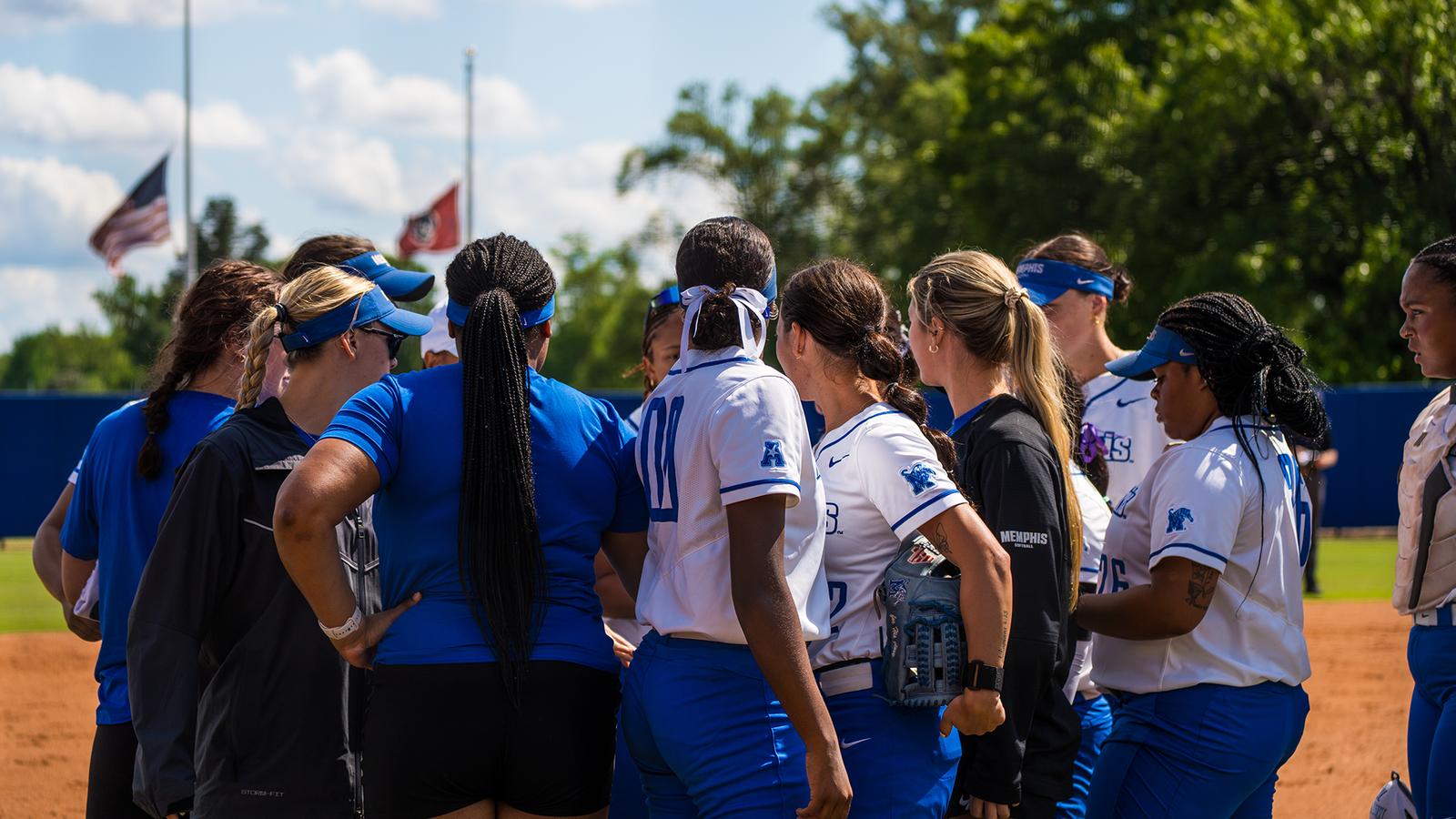
Brienesse most recently featured for Angelo State, with prior stops at UT Arlington and Seward County Community College.
“I am excited that Paris has been blessed with an extra year to play due to the NCAA junior college ruling changing,” said Prater. “I believe that her leadership and energy will be something that our young team will thrive off of. She is going to bring speed on the base paths and experience to our outfield. Her relentless grit and love for the game will be fun to coach.”
In her senior season at Angelo State, Brienesse appeared in 49 games while logging 30 starts. She hit .253 on the season with 22 hits, 22 runs scored and 22 stolen bases. Her 22 stolen bases ranked 88 at the Division II level as she helped the Rambelles to a 47-14 record, including a 34-10 mark in Lone Star Conference play.
Brienesse spent the 2023 and 2024 seasons at UT Arlington, appearing in 69 games and holding a .273 batting average while stealing 15 bases as a Maverick.
Prior to joining the Mavericks, Brienesse spent her freshman season at Seward County Community College. She held a .311 batting average in her lone season as a Saint, logging 37 hits and 20 stolen bases. She was named a second team Academic All-American in 2022.
Brienesse has also competed for the Swedish Softball National Team at the U18 and U22 levels, securing a gold medal in the 2019 U18 Swedish Softball Championships while also earning a bronze in 2020.
She joins Ellen Roberts as just the second international athlete in Memphis softball history. Roberts featured in four seasons for the Tigers, finishing with the second most wins (41) in program history in the circle.
The Stockholm native will be competing for the Swedish Senior National Team this summer in the 2025 Women’s Softball European Championship held in Prague, Czech Republic.
HOW TO FOLLOW THE TIGERS
For complete information on Memphis Tigers Softball, visit www.GoTigersGo.com and follow the team’s social media channels on Twitter, Instagram, and Facebook.
NIL
Kalen DeBoer: ‘No interest’ in talking to other schools, leaving Alabama
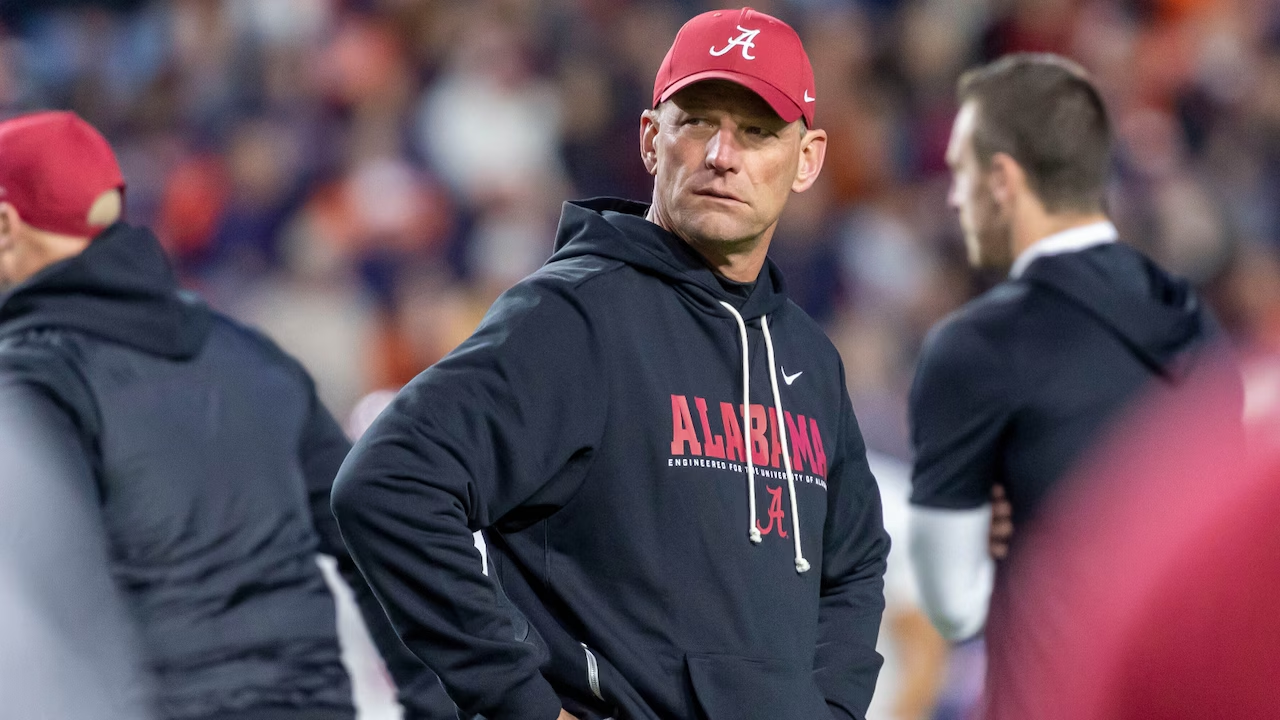
If you take Kalen DeBoer at his word, he has no interest in leaving Alabama.
As speculation runs wild about Michigan’s potential interest in DeBoer, the Crimson Tide head coach issued a written statement Sunday declaring he and his family “very happy in Tuscaloosa” and “grateful for the support.”
“We have an incredible opportunity in front of us, so my sole focus is on Alabama football and our preparations to play Oklahoma in the College Football Playoff,” the statement, issued through Alabama’s NIL collective, Yea Alabama, read.
Alabama secured the No. 9 seed in the CFP with a 10-3 season and berth in the SEC championship game, drawing Oklahoma in Friday night’s first-round game in Norman (8 p.m., ABC/ESPN).
But losses to Florida State, Oklahoma and Georgia had the Tide on the bubble when it came selection time, following a 9-4 season that kept Alabama out of the CFP in 2024.
And that’s the sticking point in Tuscaloosa. Prior to DeBoer’s arrival, Nick Saban had taken Alabama to four straight playoffs and nine national title games dating back to 2009.
Meanwhile, Michigan is suddenly looking for a head coach after a chaotic week in Ann Arbor that saw Sherrone Moore abruptly fired Wednesday after two seasons. Moore, 39, was accused of violating school policy after engaging in an inappropriate relationship with a female staffer.
He was then arrested later that day following an incident at the staffer’s residence, jailed and charged with third-degree home invasion, stalking and entering the home.
Arizona State’s Kenny Dillingham is believed to be a target, with Dillingham even addressing the Michigan talk Saturday in Tempe, as is DeBoer, a former assistant at nearby Eastern Michigan from 2014 to ‘16 and offensive coordinator at Indiana.
“I have not spoken and have no interest in speaking with anyone else about any other job,” DeBoer said in the statement. “I am fully committed to this program and look forward to continuing as the head football coach at the University of Alabama.”
DeBoer worked directly with quarterback Michael Penix at Indiana and Washington, where the duo led the Huskies to the national title game in 2023 against Michigan. He would take the Alabama job following Nick Saban’s retirement in 2024, while Michigan replaced the departed Jim Harbaugh with Moore, an up-and-coming assistant with Harbaugh’s endorsement.
Michigan’s coaching search coincides with an active investigation into the athletic department and its culture, with Moore’s actions just the latest in a long list of public relations blunders for director Warde Manuel.
DeBoer is in the second year of his eight-year, $87 million contract he inked with Alabama in 2024, averaging more than $10 million per year. His buyout is only $4 million, making it relatively affordable for another school to pluck him away.
In a coinciding statement, Alabama athletic director Greg Byrne said the school is “proud to have Coach DeBoer leading our football program at the University of Alabama. He is an incredible coach and does an excellent job with the development of our student-athletes, on and off the field.”
Byrne added: “Just as he is committed to this team, we are committed to him, and we look forward to taking the field Friday in the first round of the College Football Playoff.
NIL
College Football Is Beyond Cooked With This Latest NIL Trend

Who saw this one coming? Oh that’s right, EVERYONE!
The slow death of college football as it has been constructed for the past century will be studied someday.
The veil of amateurism has been completely lifted with the advent of NIL and the transfer portal where players can just shill themselves out to the highest bidder.
READ: NIL Lawyer Outlines Lasting Effects Of Sherrone Moore Debacle.
The latest trend might be the worst of them all, though, as we are practically treating college athletes like NFL veterans at this point.
I’m referring, of course, to programs and reporters alike announcing players “re-signing” at their current school.
Allow me to insert my obligatory “what happened to the game I love” before I go any further.
Players are out here acting like free agents in the NFL. What are we even doing here?
Let’s just go ahead and rip that Band-Aid off and stop treating these players like amateur student-athletes, because this is just the latest “point of no return” for the old days of college football.
If you were to take a time machine back, even ten years ago, and tell a fan that players would be getting social media graphics made to announce they’ve signed a contract to remain at their current school, they’d probably throw themselves out the window.
The sentiment is virtually identical, as even modern fans see the ridiculousness in all of this.
It’s a sad state of affairs for anyone who considers themselves a college football traditionalist, as I’m sure even the staunchest defenders of NIL at its inception didn’t have something like this in mind.
Remember when this was just supposed to be so players could make money off the field without having the commies at the NCAA come down on them with an iron fist?
Now, some of these players are making more money than players on their rookie contracts in the NFL.
I’m all for the players getting a slice of the pie, but if this is what we are moving towards, why do we even have academic standards as it is?
As a wise man once said, “We ain’t come here to play school.”
That was ten years ago, and Cardale Jones sounds like a prophet now.
We are hurtling towards a junior league for the NFL, though I fear we have already gone too far to reverse course now.
NIL
CBS Sports ranks Top-25 transfer players in College Football Playoff

One aspect of the offseason that affects teams and contenders every single year now is the NCAA Transfer Portal. Now, ahead of the College Football Playoff, we can see how some of those additions panned out for programs that made the field based on a recent ranking done by those at CBS Sports.
In an article from Friday, CBS Sports rated the Top-25 transfers across the dozen teams who will be in the CFP. Of them all, Oregon led the way with four names on this list, which tracks as they finished fourth last offseason in On3’s 2025 Team Transfer Portal Rankings. Five other teams then had three apiece, with all of them finishing in the Top-20, including two in the top-five and the one who was ranked as the best portal class in the nation, per that same rating from On3.
And, of the fifteen of them who transferred this last offseason, eleven of them were in the Top-100, including six who were in the Top-10, of On3’s Industry Ranking of 2025’s Top Transfer Portal Players. Ten were then in the Top-10 of their respective position, four of those being the top overall player at their position, in that rating from On3.
Needless to say, players like these are what make this next part of the year so important, with the one-time portal window set to open on January 2nd. Before we get to that part of the calendar, though, let’s take a look at these past transfers who could end up helping a team win a national title this season, as rated by CBS Sports:
Even in two days of hindsight, this ranking at number one looks even more spot on. That’s as, as of last night, Mendoza, the quarterback of the top-seeded team in the country in the Hoosiers, won the Heisman Trophy, as the first winner of the award in program history up in Bloomington.
A transfer from California, who was the No. 12 overall player and the No. 4 QB in the portal per On3, in his first season with IU, Mendoza has been one of the best quarterbacks in the country with a career season at 71.5% completion for 2,980 yards, a national best of 33 touchdowns, and six interceptions, while also rushing for 240 yards and six more scores. Now, after leading them to an undefeated record and a Big Ten Championship, and after hosting the Heisman last night in NYC, Mendoza will lead Indiana, the No. 1 overall seed, into the field in hopes of making more history in the CFP.

Texas Tech, which had the No. 1 overall class in the portal per On3, had three names on this list just from their defense. Bailey leads that, after being a top-ten overall transfer and the second-best defensive end in the portal at On3, with what he did this season in Lubbock.
Transferring in from Stanford, Bailey had a career-best season with 43 total tackles, with 17.5 being for loss with 13.5 sacks, three forced fumbles with one recovery, and a deflection for the Red Raiders. Production like that is a big part of Texas Tech, with them posting a top-five overall defense, having the best season in school history at 12-1, winning the Big 12 Championship, and making their debut in the CFP.
Downs has been impactful at Ohio State since his transfer two offseasons ago from Alabama. He now may be part of a national title winner, with the Buckeyes having a chance to go back-to-back in the College Football Playoff.
As an anchor on the backend of their defense, being one of the best players in all of college football, Downs, who received Heisman votes as a safety as well as won the Thorpe Award, has had 60 more tackles, 5.0 being for loss with one sack, with two interceptions and two deflections. That has been part of what has led the top overall defense in the country this season, as Ohio State enters as just a one-loss team to be the No. 2 overall seed in the CFP.
Sayin did the exact same thing as Downs, as he transferred two offseasons ago from Alabama, after signing there before the retirement of Nick Saban, to Ohio State. This was his first season as the starter, though, and it has been quite the year he had in Columbus.
Sayin posted a national best in completion rate, and one of the highest all-time, at 78.4% en route to 3,323 yards, 31 touchdowns, and six interceptions for the Buckeyes, which also had him as a finalist last night for the Heisman Trophy. Now, on one of the best teams in the country, Sayin will attempt to lead Ohio State to a second consecutive national title in the College Football Playoff.
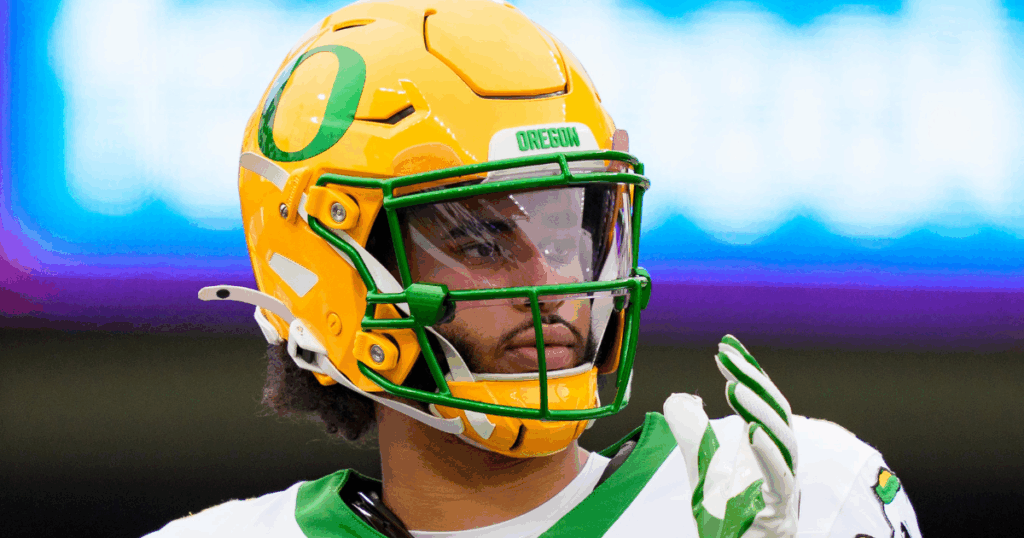
After starting as a freshman at UCLA, Moore transferred two offseasons ago and sat as the backup last year at Oregon. Now, a year later as the starter, that decision has paid off with what he did in Eugene, as he rounds out the top-five here for CBS.
Moore posted 72.5% completion for 2,733 yards, 24 touchdowns, and six interceptions for a top-fifteen offense this season for the Ducks. He’ll now lead Oregon, in a very favorable position as the first of the non-bye teams at No. 5 overall, into what could be run of retribution for them after what happened last year in the CFP.
Texas A&M was one of the best defenses in the nation this year when it came to pressures and tackles for loss. Howell was then the biggest part of that effort in what was his second season in College Station after originally transferring from Bowling Green.
Howell posted the best campaign of his career this year with the Aggies with 29 tackles, 14.0 of those being for loss with 11.5 sacks, along with six deflections and one forced fumble. He’ll now look to continue wreaking the same havoc in the playoff, with A&M set to open up with a home game at Kyle Field.
After the first two weeks of the season, one name that wasn’t expected to be on a list like this would be Chambliss. However, with the play as well as an injury to QB Austin Simmons, Chambliss took full advantage of the opportunity that came his way this year in Oxford after transferring to be a backup from out of Ferris State (DII)
Chambliss, a Top-40 QB in the portal last offseason per On3, went on to post a total of 290.5 total yards per game and 24 touchdowns overall, with 3,016 yards and 18 touchdowns coming as a passer at 65.5% completion, for the Rebels. He’ll now look to keep their offense humming, despite the coaching changes the past two weeks, in what’ll be their debut appearance in the playoff in the ‘Sip.
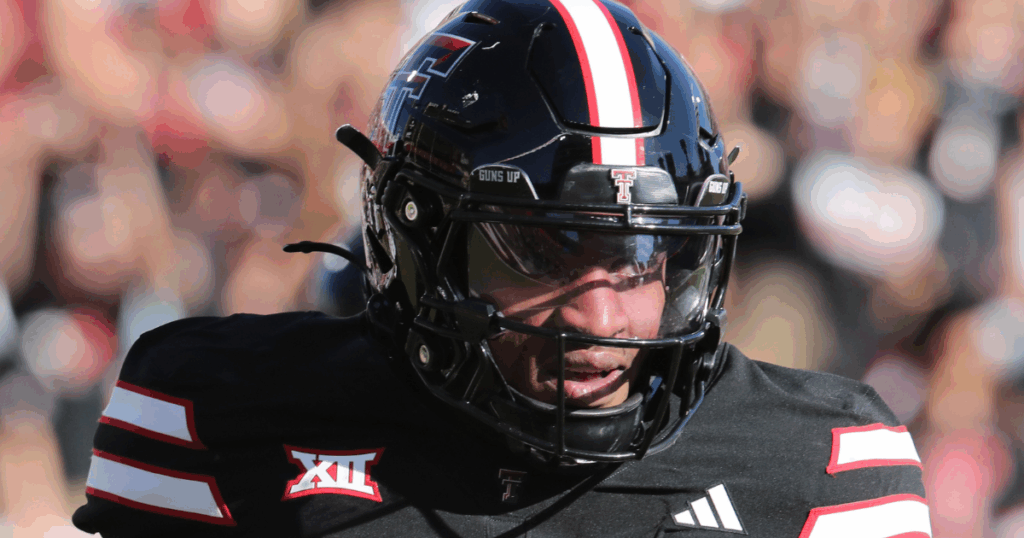
Going back to the defense for the Red Raiders, Height is another defensive end that’s had a great first season in Lubbock. That’s after transferring in last offseason, after being a top-fifty player in the portal and in the top-ten among edges at On3, from Georgia Tech, after beginning his career with two seasons apiece at USC and Auburn.
On that same unit, Height posted some career-best numbers of 33 total tackles, 10.5 being for loss with 9.0 sacks, to go with two forced fumbles, with a recovery, as well as a deflection. That has two pass rushers in the top-ten here at CBS for Texas Tech, who hopes to see both keep causing those kinds of problems for their eventual opponents in the CFP.
Oregon was seen to have one of the better offensive lines in the country this season. A major piece of that was Pregnon, who was a top-thirty overall transfer and the second-best interior lineman after two seasons apiece at USC as well as Wyoming.
Pregnon did not allow a sack this season as part of that line. And, behind him, the Ducks had a top-fifteen total offense at 38.2 points and 246.8 yards per game, with them hoping to have the same output in this appearance in the CFP.
Concepcion was already one of the better wide receivers in college football after his first stop with two years spent at NC State. He then, after being a top-ten overall transfer and the second-best receiver in the portal per On3, was even better this fall for Texas A&M.
Concepcion was the leading pass catcher for the Aggies this season with 57 receptions for 886 yards, averaging 73.8 per game and 15.5 a catch, and nine touchdowns. He, along with their second-leading receiver not too much further down this ranking, will now try to be just as explosive in the pass game as A&M prepares to debut in the College Football Playoff.
11. Miami DE Akheem Mesidor
12. Ole Miss RB Kewan Lacy
13. Texas Tech DT Lee Hunter
14. Oregon DB Dillon Thieneman
15. Oregon OT Isaiah World
16. Indiana LB Aiden Fisher
17. Miami DB Jakobe Thomas
18. Texas A&M WR Mario Craver
19. Georgia WR Zachariah Branch
20. Miami QB Carson Beck
21. Alabama WR Germie Bernard
22. Ohio State CB Davison Igbinosun
23. Oklahoma WR Isaiah Sategna
24. Indiana CB D’Angelo Ponds
25. Tulane QB Jake Retzlaff
NIL
$87 million college football coach comments on rumor he’s leaving for Big Ten team

Following a 2025 season full of coaching changes, one of the biggest gigs in the game still remains open. The Michigan Wolverine football program fired head coach Sherrone Moore after two seasons at the helm after he took over for Jim Harbaugh, leaving the team in need of a need coach for the second time in three years.
What’s tricky for Michigan is the timeline. Since Moore’s firing was credited to non-football reasons and came at an abrupt moment, the Wolverines are hopping on the carousel after everyone else already has a seat. Lane Kiffin made his big move, the SEC had half-a-dozen teams total make a coaching swap, and even Penn State, a conference rival for Michigan, finally found a solid fit in Iowa State’s Matt Campbell.
But that doesn’t mean the Wolverines’ leadership won’t aim high. They reportedly had the head coach of Alabama, Kalen DeBoer, as one of their options at the outset of the search. Even prediction markets like Kalshi reflected a sentiment that DeBoer would be in the mix in Ann Arbor. At least, that’s if he wanted to be.

As of Sunday evening, Alabama fans can rest easy knowing their second-year head coach is all the way painted in Crimson from head to toe and ready for a big postseason run. After speculation had bubbled to the social media streets, DeBoer shut it down with the following statement:
“My family and I are very happy in Tuscaloosa and remain extremely grateful for the support of President (Peter) Mohler, Greg Byrne, the Board, and so many others,” DeBoer said, according to Yea Alabama, the school’s official fan experience page. “We have an incredible opportunity in front of us, so my sole focus is on Alabama football and our preparations to play Oklahoma in the College Football Playoff.”
Kalen DeBoer, Alabama working on extension to $87 million contract
If a statement wasn’t enough to convince fans of his loyalty and Alabama’s as well, the two sides are reportedly entered in contract extension talks, according to On3’s college football insiders, Chris Low and
“Kalen DeBoer and Alabama are in ongoing talks about an extension, but nothing has been agreed upon or signed,” On3 posted on X Sunday evening. DeBoer is already signed for quite a while Ahead of his first season, 2024, DeBoer arrived from the West Coast and inked a deal worth $87 million over eight seasons. He’d still have six more years left on that contract after wrapping up this College Football Playoff run.
However, as has been the case for many coaches mentioned in rumors for other jobs, the schools may just want to re-sign another deal to signal to fans that no, their man is not going anywhere for now.
More on College Football HQ
NIL
Dick Vitale, Charles Barkley call out College Football Playoff committee over Notre Dame snub

Six days after Notre Dame missed the College Football Playoff, the Fighting Irish’s absence is still a point of conversation. During Saturday’s Kentucky vs. Indiana basketball game, Dick Vitale and Charles Barkley shared their reaction, calling out the CFP committee in the process.
Vitale, of course, wears his Notre Dame fandom proudly. He spoke out on social media shortly after the final rankings came out this week, when the Fighting Irish became the first team out of the CFP while Miami jumped up to No. 10 due to the head-to-head matchup between the two teams.
As ESPN showed a promo for this year’s College Football Playoff, Vitale made his thoughts clear. He argued Notre Dame deserved to be in the bracket, especially considering the Irish were in that position throughout the five weeks of CFP rankings shows.
“I’m so frustrated looking at that, Notre Dame not in there,” Vitale said on the broadcast. “Notre Dame deserved to be in.
“Five weeks in a row, we have a show on ESPN where we give the Top 12 teams, make a big thing out of it every Tuesday. Big show. Here comes the committee. Bottom line is, they were all five [weeks] in the Top 12. Then, all of a sudden, bumped.”
Charles Barkley: ‘You could see’ Notre Dame absence coming
Charles Barkley agreed with Dick Vitale, expressing his disappointment with Notre Dame’s absence. However, he said it might not have been entirely surprising considering the penultimate rankings announcement. The Fighting Irish dropped to No. 10 while Alabama moved to No. 9. BYU sat at No. 11, putting a team between Notre Dame and Miami, therefore avoiding the head-to-head discussion.
That said, Barkley argued Notre Dame is a different team than it was when it played Miami in Week 1. As a result, he thought the Irish should have been in the field.
“I actually agree with you. … I was disappointed,” Barkley said. “But you could see it coming in the last couple polls. They were creeping up on Miami. And my biggest problem with the whole thing, everybody’s talked about head-to-head. First of all, that was in August. … They were very close games [against] A&M and at Miami.
“But your team is not the same in August as it is in December. Notre Dame is playing as well as anybody in the country other than Indiana and probably Ohio State. And I don’t want to leave out the [Georgia] Bulldogs. Kirby Smart, that man can really coach.”
NIL
2026 Heisman Trophy: CBS Sports names front-runners for the college football’s top award

The 2025 Heisman Trophy race is in the books, and now the college football world can turn its attention to the 2026 Heisman Trophy race. There, it should be a highly competitive race with several players set to return who look like candidates for college football’s top award.
Ahead of the 2026 season, CBS Sports took a look at those candidates. That included sorting them into two categories. That’s the top Heisman contenders for the 2026 season and other names to know for the race. Of course, there’s plenty of room for surprises beyond that too.
Several players who CBS Sports lists could be on the move next season. That includes in the Transfer Portal or going into the NFL Draft. So, with the offseason just around the corner, there’s time for things to change.
Top Heisman contenders in 2026
Arch Manning, QB, Texas Longhorns
Texas Longhorns quarterback Arch Manning got his first action as a starter in 2025. That moment had been highly anticipated since he was in high school and it came with mixed results. Still, with another year of experience, he very well could contend for the Heisman Trophy.
Of course, Manning does have the option to enter the NFL Draft. That’s not what most people anticipate, though, as returning to Texas for another season should help him improve that stock. Certainly, being a Heisman winner wouldn’t hurt either.
Julian Sayin, QB, Ohio State Buckeyes
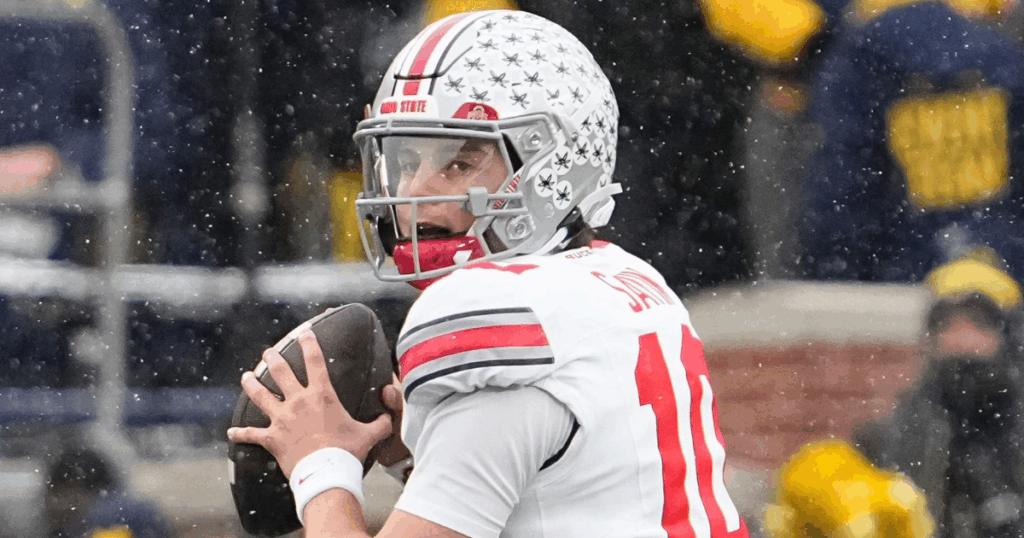
It was a disappointment in New York for Ohio State quarterback Julian Sayin. A Heisman finalist this season, he didn’t end up going home with the hardware. Instead, he’ll have to refocus on the College Football Playoff and winning on the field.
As a redshirt freshman, Sayin was a Heisman finalist. He’ll be back again in 2026 with added experience that is almost impossible to find in college football. So, there’s no reason why he can’t win.
Jeremiah Smith, WR, Ohio State Buckeyes
Coming into the 2025 season, Jeremiah Smith was commonly thought of as the best receiver in all of college football. He wouldn’t end up winning the Biletnikoff Award or being a Heisman finalist, though he was still thought of as the most talented receiver in the country.
Just a sophomore, Smith will be back next season and will, once again, be among the most thrilling players in the game. The only concern is whether or not he and Sayin will steal Heisman votes from one another.
Marcel Reed, QB, Texas A&M Aggies
Marcel Reed has been a revelation at quarterback for Texas A&M. The Aggies’ signal caller led Texas A&M to the College Football Playoff and has made them a legitimate threat to win the national championship. He’d use both his arm and legs to get there too.
As one of the most exciting players in the game who plays on a massive stage in the SEC, Reed is going to have the spotlight on him in 2026. If he plays up to his capability, he’ll be in the Heisman conversation once again. There’s no reason to think he can’t win it too.
Jayden Maiava, QB, USC Trojans
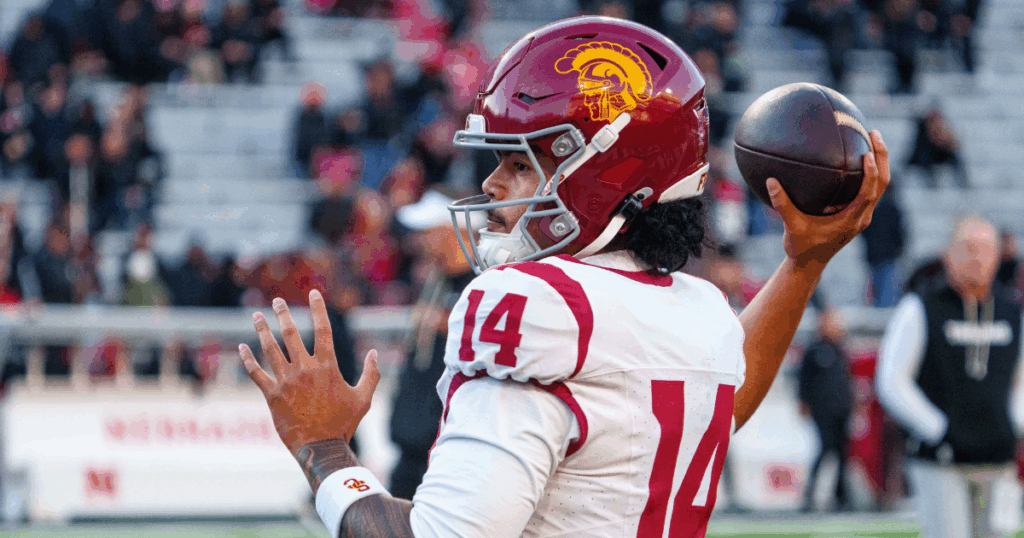
After taking over as the USC starter late in 2024, Jayden Maiava would hit his stride in 2025. Now, he and head coach Lincoln Riley are looking for a way to build on that once again.
If there is one thing that Lincoln Riley has found success doing it’s developing quarterbacks and explosive offenses. That’s led to Heisman Trophy success, including at USC. So, it’s not unfair to have high expectations for next season.
Other names to know
Ty Simpson, QB Alabama Crimson Tide
Alabama quarterback Ty Simpson is eligible to turn his attention to the NFL Draft next season. If he chooses to return to college, though, Simpson is going to be viewed as one of the best quarterbacks in the entire sport. He could very well even be a Heisman contender.
Gunner Stockton, QB, Georgia Bulldogs
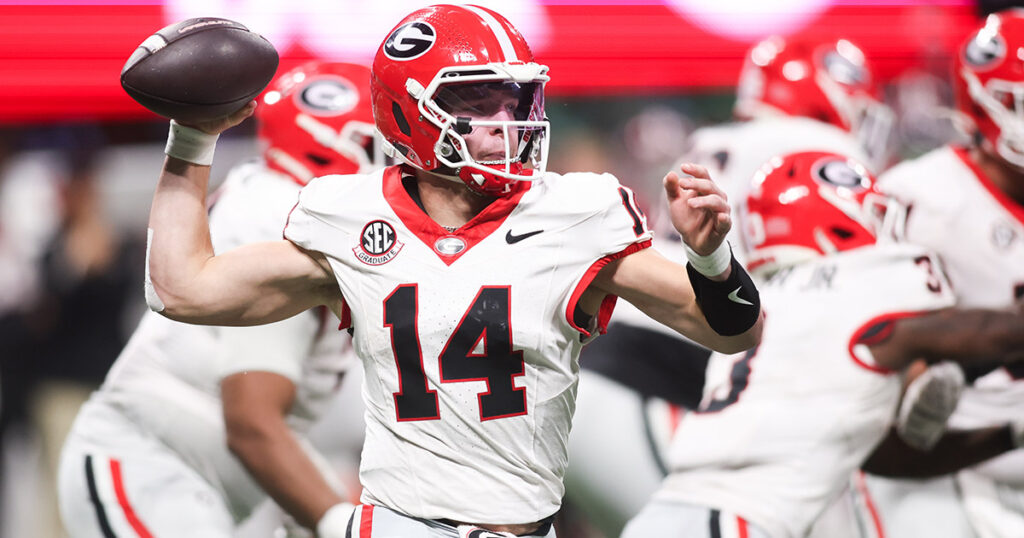
Georgia managed to win the SEC and a first round bye in the first season Gunner Stockton led the Bulldogs as their starting quarterback. He’ll likely be back next season with much higher expectations from the jump. So, he could feasibly end up in the Heisman race more so than he was in 2025.
Drew Mestemaker, QB, North Texas Mean Green
There is a chance that Drew Mestemaker could be a transfer this offseason, as his head coach is on his way to Oklahoma State. That comes after the pair combined for a phenomenal season at the Group of Five level. With more attention on him from the start, regardless of where he’s playing, the Heisman isn’t out of the question.
Sam Leavitt, QB, Arizona State Sun Devils
For the past two seasons, Sam Leavitt has been vital to making Arizona State one of the best teams in the Big 12. Now, there are rumblings that he could transfer. Regardless of where he ends up, Leavitt should be a Heisman contender.
Ahmad Hardy, RB, Missouri Tigers
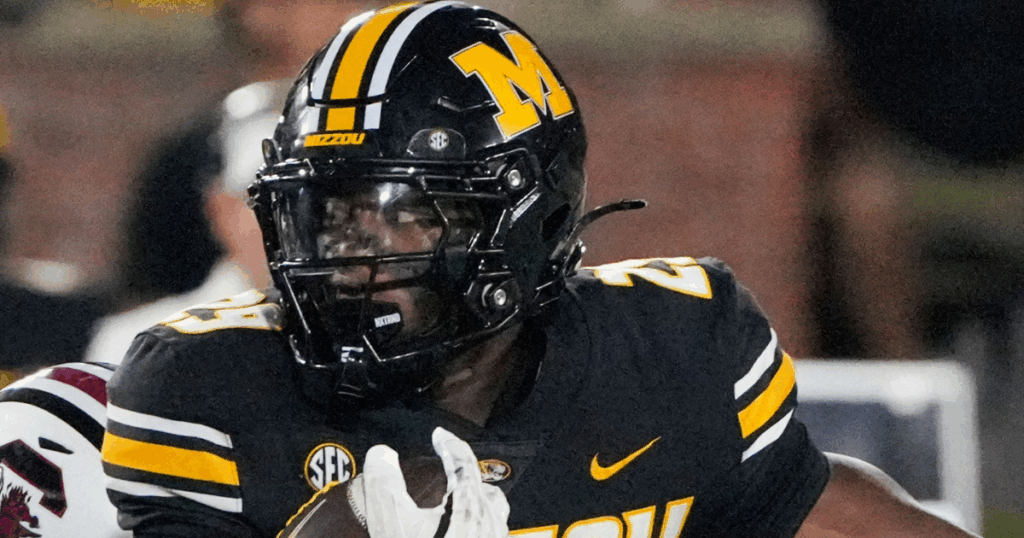
The Missouri Tigers managed to find one of the best running backs in the entire country this season, bringing in Ahmad Hardy. He’d rush for 1,560 yards and 16 touchdowns in 2025. If he can build on that in 2026, the Heisman may not be able to ignore his success.
Kewan Lacy, RB, Ole Miss Rebels
Another running back to keep an eye out on for the Heisman race next season is Kewan Lacy. The Ole Miss running back had 20 rushing touchdowns this year. That’s hard to ignore, but it’s also hard to replicate.
-

 Rec Sports3 weeks ago
Rec Sports3 weeks agoFargo girl, 13, dies after collapsing during school basketball game – Grand Forks Herald
-

 Motorsports3 weeks ago
Motorsports3 weeks agoCPG Brands Like Allegra Are Betting on F1 for the First Time
-

 Sports3 weeks ago
Sports3 weeks agoTwo Pro Volleyball Leagues Serve Up Plans for Minnesota Teams
-

 Sports3 weeks ago
Sports3 weeks agoUtah State Announces 2025-26 Indoor Track & Field Schedule
-

 Sports3 weeks ago
Sports3 weeks agoSycamores unveil 2026 track and field schedule
-

 Motorsports3 weeks ago
Motorsports3 weeks agoRedemption Means First Pro Stock World Championship for Dallas Glenn
-

 Motorsports2 weeks ago
Motorsports2 weeks agoJo Shimoda Undergoes Back Surgery
-

 Sports3 weeks ago
Sports3 weeks agoTexas volleyball vs Kentucky game score: Live SEC tournament updates
-

 Rec Sports2 weeks ago
Rec Sports2 weeks agoHow this startup (and a KC sports icon) turned young players into card-carrying legends overnight
-

 NIL2 weeks ago
NIL2 weeks agoBowl Projections: ESPN predicts 12-team College Football Playoff bracket, full bowl slate after Week 14



























